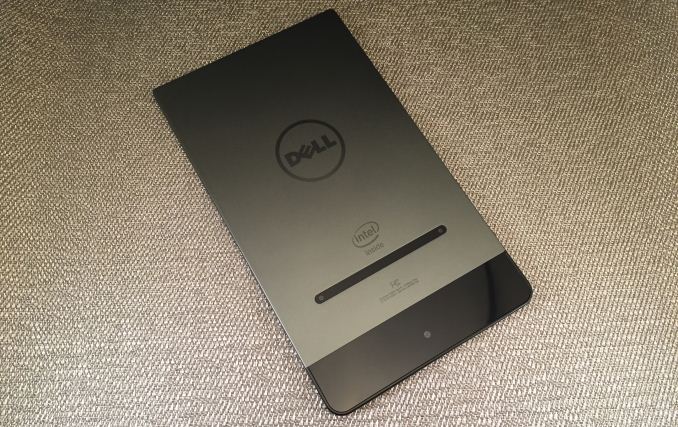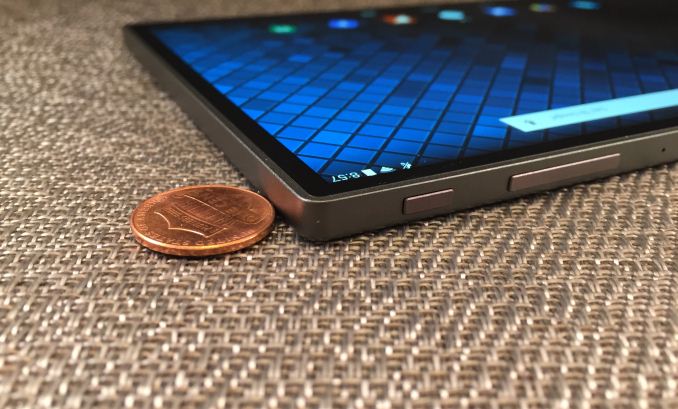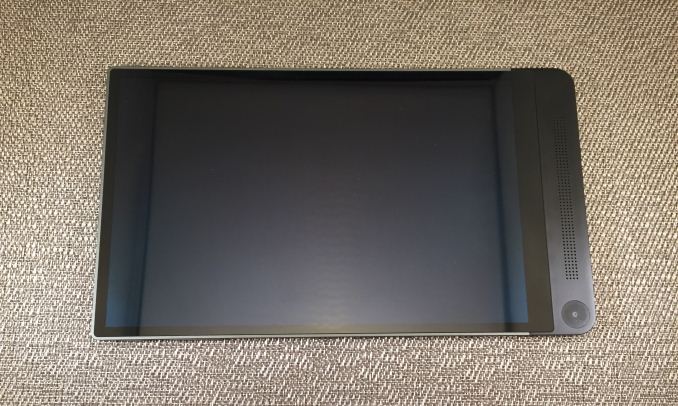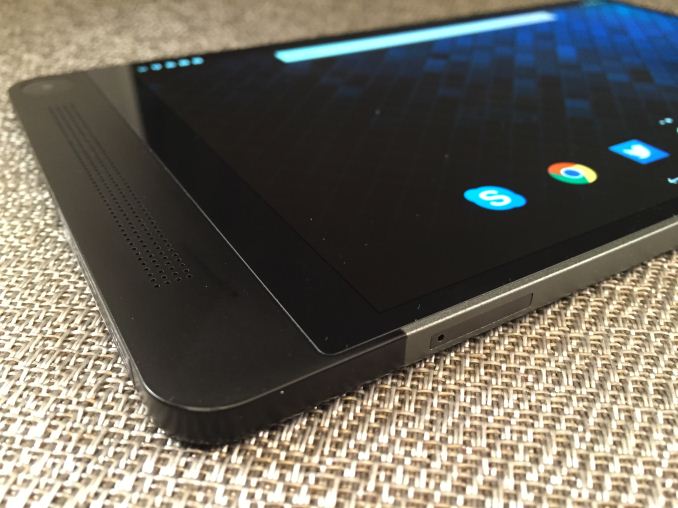The Dell Venue 8 7000 Series Review
by Brandon Chester on March 12, 2015 8:00 AM EST- Posted in
- Tablets
- Dell
- Android
- Mobile
- Venue 8 7000

Five years ago, the first of what we would call modern tablet computers were released to the world. What is now an entire product category was originally seen with massive skepticism by many consumers, analysts, and journalists. Even those who had high hopes for the future of tablets could not have predicted their meteoric rise in popularity and ubiquity.
Although tablets are still derided by many as being useless for productivity work, there are many cases where a consumer has been able to not just supplement, but replace their traditional computer with a tablet. Of course, as tablets made by companies in the mobile space replace traditional computers, the producers of those computers are faced with a problem of maintaining profit and relevance. The inevitable move was for PC companies to produce their own tablets to compete with their new competition.
This brings us to the Dell Venue 8 7000 Series tablet, also known as the Dell Venue 8 7840. Although there have been other Venue 8 tablets, for the remainder of the review I will refer to the Dell Venue 8 7840 as the Venue 8 as the full name is quite long and there shouldn't be any risk of confusion with older Venue 8 tablets. Dell is actually not a brand new player in the tablet space, nor are they new to the mobile space.
Some people may remember the Dell Streak 5, which was a 5" phone that could be called one of the first phablets on the market. However, Dell is still not a well known player in the mobile space despite their previous attempts to break into it. On paper, the Venue 8 has all the attributes required of a flagship tablet, but whether or not it's enough to make Dell a serious contender remains to be seen. Before discussing the design of the Venue 8, I've laid out its specifications below to give an overview of how the Venue 8 stacks up to the competition.
| Dell Venue 8 7840 | |
| SoC | Intel Atom Z3580 Moorefield quad core Atom with 2.33GHz burst speed, PowerVR G6430 |
| RAM/NAND | 2GB LPDDR3, 16GB NAND + microSDXC |
| Display | 8.4" 2560x1600 AMOLED |
| Dimensions | 215.8 x 124.4 x 6.0 mm, 306g |
| Camera | 8MP Rear Facing + 2x 720p Depth Cameras 2MP Front Facing |
| Battery | 5900mAh (21Wh) |
| OS | Android 4.4.4 KitKat |
| Connectivity | 1x1 802.11a/b/g/n/ac + BT 4.0 , USB2.0 LTE SKU Available |
| Price | Starting at $399 |
As you can see, the Venue 8 is a high end device in most areas, at least when evaluated on paper. The limited storage configuration of 16GB is one of the few question marks, though the microSD slot helps; the GPU is also going to be potentially limiting. Note that Dell also offers an optional wireless keyboard/case as an accessory. The rest of the review will determine how well these specifications translate into a good real world experience, but before jumping into the technical details it's important to discuss the design and ergonomics of the Venue 8.
One big selling point for the Venue 8 is that it's currently the thinnest tablet in the world according to Dell. Both Apple and Sony have tablet offerings that are 6.1mm thick, but Dell has shaved off that decimal point and made a tablet that is exactly 6mm thick across the entire chassis. I can't really tell the difference between the thickness of the Venue 8 and the iPad Air 2, but both devices are remarkably thin. The Venue 8 feels even more impressive than the iPad at times because it's smaller and significantly lighter in addition to being thinner. The bulk of the chassis is made of aluminum, with a small plastic region at the bottom to house the speakers and camera. The whole device feels great in the hand, and the aluminum feels solid and sturdy.
However, there is a unique aspect of the Venue 8's design that needs to be addressed, which are the unconventional bezel proportions and speaker positioning. On most tablets, you'll see a bezel of equal width on every side, or a a pair of equal bezels on the top of bottom, and a pair of equal thinner bezels on the left and right sides that are thinner than those on the top and bottom. The Venue 8 with its Infinity Display instead opts to use very thin bezels of equal width on the top, left, and right, and a thicker bezel on the bottom. This is necessary to provide space for the various circuitry and display drivers that are required. In addition, Dell has placed the front-facing camera and a pair of stereo speakers in a section beneath bottom bezel.
This leads to an unconventional and unfortunately unbalanced bezel design, and it can cause some issues when holding the tablet. In portrait mode the fact that there's a larger bezel and a speaker at the bottom of the tablet doesn't pose much of an issue, but in landscape mode it makes it uncomfortable to hold. It's hard to hold the Venue 8 in landscape without it feeling uneven. This is exacerbated by the fact that the bezel on top of the tablet is extremely thin.
The thinness of the other bezels can also pose their own issues with having fingers rest on the display. When Apple first used asymmetric bezels on an iPad with the iPad Mini, they tweaked the touch rejection in iOS to account for the fact that fingers were more likely to be resting on the display. Android has no such accommodation, and there have been instances where I find myself unable to scroll or accidentally zooming because one of my other fingers is resting on the display and being detected as touch input.
Overall, I think the Venue 8 is a well designed device with exceptional build quality. It feels remarkably thin and light in the hand, and its flat edges are visually striking while still remaining ergonomic due to the tablet's thinness. The aluminum construction also ensures that there's not even the slightest bit of flex to the chassis. Like every device, it's imperfect. The bezel design is visually impressive, but hampered by technological limitations and some software issues. I also have mixed feelings about the camera placements. Despite its issues, the Venue 8 still remains a tablet that both looks and feels like a premium device.













89 Comments
View All Comments
Sushisamurai - Sunday, March 15, 2015 - link
Hell, even CNET and sister sites quoted anandtech when the cheating was found/occurred. That's some pretty big influence there. What about the times when they got GPU architectures from imagination and the like (we still miss u anand), that was also to "OEM recommendations". I feel AT's done some good work in terms of pushing the consumer/review industryaz060693 - Friday, March 13, 2015 - link
Cirrus Logic DAC? I really want to see how good the audio output is.zodiacfml - Friday, March 13, 2015 - link
Dell, why bother? Why not compete with Asus's convertible laptops with this type of hardware.shadarlo - Friday, March 13, 2015 - link
Tablets that cost >$150-$200 should always come with usb-c, HDMI, or display port out. There are basically no exceptions to that, but it's even more true if it's a Windows tablet. Not having a 2nd USB port and a video out port on a windows tablet is beyond stupid.This being android and $400 is a hard sell to me. I just can't understand the purpose of a $400 android tablet unless it had phone functionality built into it. If it was a phone as well it'd be AWESOME.
FXi - Friday, March 13, 2015 - link
Too bad there isn't a Win 8.1 version. Might have actually sold a bunch thenWolfpup - Thursday, March 19, 2015 - link
Regarding that CPU...I thought that all second gen Atoms were going to be using Intel's GPUs from now on? I had no idea they had any running PowerVR still.I thought that sounded like a bad idea for driver support until I realized this was an Android tablet (thought it was Windows 8 at first) and lost interest.
BUT I'm still curious as to why there's a second gen Atom chip shipping with PowerVR instead of an Intel GPU.
All the ones I've seen until this are 4 core parts that are fairly slow clocked. Not exactly great considering a 20 or even 40 core part isn't a powerhouse, but at least it means they're driver compatible with Intel's other GPUs.
Wish that Nvidia had been able to license x86 and we had Tegra K1 tablets running Windows 8, complete with a GPU that would actually run modern games semi-decently. THAT would have been seriously cool (well, assuming the CPU part was fast enough LOL).
Razzy76 - Friday, March 20, 2015 - link
Android ruined this tablet.NamelessTed - Tuesday, March 24, 2015 - link
If this tablet were running Windows it would be much more compelling to me. I got an nVidia Tegra Note tablet when they first launched and it has been a great product. The longer I use it the more I wish I had a slightly bigger screen and that I had the ability to use Windows. Within the next year I really really hope we see a sub-$400 Windows 10 tablet with front facing speakers and an 8-9" display.Angelina Mathews - Monday, July 18, 2016 - link
Hello everyone !! I am really very excited to share my experience of using Dell Venue 8 Pro 3000 Series Tablet. Though it is shocking but also the fact that at starting when I purchased this tablet I was not confident about my decision since I was using tablet of this brand for the very first time but then later on after being a user of it I realize that this tablet is actually highly efficient. It being powered a host of Windows 8.1 business specific features and applications facilitates the users with an amazing working experience. To know more, click here - http://delltablet.laptab.in